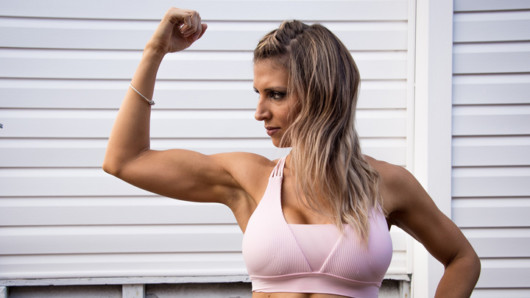After a long year of lockdowns, people are emerging back into the world to pick up where they left off in life. Others may be taking this opportunity to get a fresh start and make healthier life choices. With gyms opening up again, many people may even be thinking of starting up a workout routine.
The benefits of working out are undeniable. You look better, you feel healthier, and your mental health improves. So why doesn’t everybody do it? Getting started is easy.
Maintaining a consistent routine is itself an exercise in mental fortitude. It requires discipline, endurance, and patience. This gets even more challenging when you’re older. It’s hard to get motivated when you aren’t used to an active lifestyle. And even once you’ve started, it can be discouraging to see how far ahead other people are. How they’ve already made the kind of progress you can’t seem to reach. These are the kind of head games we play that only hold us back.

Trust me, I know the struggle. I was a college student set on my diet plan of beer and pasta when the notion of getting in shape struck me. It was about a month after deciding I should work out that I built some semblance of a routine. It’s been a wild ride of false starts, relapses into bad habits, and insecurity. There were plenty of times I would want to give up because I wasn’t getting rail-thin and shredded.
Despite all that, I’ve been sticking through it for the past six years. I have noticed not only physical results, but a general zest for life. I’m now also more confident in myself than I’ve ever been.
1. Start Slow
So, you’ve decided to start working out. Great! All journeys start with that first step. Now before you pledge to spend 6 or 7 days in a row at the gym trying to bench your bodyweight, consider this. Jumping right into overdrive may work well for the first couple weeks, but you’ll burn out sooner than later. If working out is new to you, it can be a challenge to make it a consistent part of your daily routine.
I would suggest starting with the goal of working out 3 days a week for about 45 minutes each session. The four rest days will give your body ample time to recover and the short workout times will keep you focused. Once that’s become easier, add another day. I find that four days is more than enough for me, but that will be for you to decide later.
Starting slow also applies to your workout itself. It can be tempting to want to meet the limits of your strength right away. Yet this, too, can lead to burning out or even long term injuries.
I can’t stress enough how important it is to ease yourself into new workouts. There’s nothing wrong with spending a few weeks getting used to bicep curls with a 15 or 20-pound weight. It’s better than forcing out a couple of 50-pound curls on day one and hurting your wrist (which I’ve done). This leads to my next piece of advice.
2. Make Short Term Goals
As cliche as it sounds, this is a marathon, not a race. To expect immediate results will lead to a lot of disillusionment and frustration. Your best move is to set short term goals, my dad would call these base hits. This is a great way to keep from overwhelming yourself.
Let’s say your goal is to drop 20 pounds. Simple enough, but it takes time. It could feel like forever before you get there. This is where those base hits come into play. These are those short term goals that you need to take to reach your ultimate goal of losing 20 pounds.

So, where do you start with this goal? Well, your first base hit could be to figure out which workouts will help you lose those 20 pounds. Doing the homework counts if you know how to create an effective workout. The second base hit could be to spend a week doing that routine. The third could be to up the intensity of those workouts. As you progress, your goals will follow suit.
When it comes to building a workout routine, it can be tempting to look too far ahead. We get so wrapped up in the abstract of our lofty goals, that we lose sight of what is in our reach. Setting up short term goals keeps us grounded and keeps our journey moving.
3. Don’t Compare Yourself to Others
When I first started working out, I felt intimidated by how much weight people were lifting. It’s hard not to think this way when you’re a doughboy among hardbodies. In my mind, I figured that if I could squat and deadlift my body weight, I’d start to get that lean athletic look that they had. Over time, I got my squat up to 200 lbs and my deadlift up to 300 lbs. Both of these feats resulted in injuries that put me in physical therapy and kept me out of the gym for a few weeks. Was it worth it? No. Even though I had met my lifting goals, the injuries they caused ended up setting me back. Worst of all, these feats of strength didn’t lead to anything resembling a six-pack.
I know it can seem like there’s a lot of pressure to perform in the gym, but much of that pressure comes within. The truth is, you don’t have to lift heavy. I’m not saying that you shouldn’t challenge yourself. Pushing the limits of what you thought you could do is one of the best parts of working out. What I am saying is that there’s a fine between pushing yourself and hurting yourself.
Work at a progression that feels right to you. If you’re working out next to someone lifting double your weight, pay them no mind. They’re on their own path. Focus on you. Don’t rush to lift heavy.
4. Do It for You
It’s great that you want to start working out, but you need to ask an important question. Why? The answer may seem obvious to you, “I wanna get buff!” or “I wanna lose weight!” or “I want a six pack!” That’s all well and good, but why? Why do you want to get buff? Why do you want to lose weight? Who cares if you have abs? Do you want to do these things? Or do you feel like you should? The difference here is subtle, but important. Of course, you should get in shape so that you live a longer and healthier life. The year of the pandemic showed us how important it is to maintain a healthy lifestyle. Yet, none of that matters if you haven’t figured out why you want to do it.
Going to the gym out of an arbitrary sense of duty isn’t sustainable. Go because you want to. Because you love the feeling of meeting a goal you set for yourself. I’m NOT saying you should slack off on the days you aren’t motivated. Those are actually the days you SHOULD push yourself. But if this drive to get in shape doesn’t come from genuine desire, it won’t last. If you don’t leave feeling like you’ve done what you want to do, why did you go?

Maybe going to the gym isn’t for you. That’s also fine. There are plenty of ways to get in shape that don’t involve lifting. Maybe running is your thing. Maybe you need to focus on nutrition. Maybe you’re a yoga or home workout person. The point is, this kind of self-reflection is necessary for building up any kind of routine. If you’re trying to build a gym routine, you need to answer two questions. “Do I want to?” and “Why do I want to?”
Starting a gym routine is easy. All you have to do is show up. The hard part is coming back. A lot of people miss the mark on endurance. They set themselves up for failure by going too hard and burning out. People also don’t take the time to ask themselves what they’re trying to get out of working out. This lack of direction can lead to discouragement and keep you from coming back.
You should approach keeping up a routine like you would with any new and difficult task. Do it with a sense of patience, not just with the process, but with yourself as well. Treat yourself with kindness, no matter how frustrated you may get. Give yourself credit for the progress you make, even if it seems small. Above all else, remember that you’re in it for the long haul and you’re in it for you.
Author Bio:




